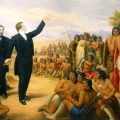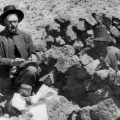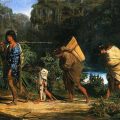
Indians, according to the non-Indian social philosophers, bureaucrats, and politicians of the nineteenth century, were going to simply disappear by the end of the century or in the early twentieth century. Many history books about Indians stop their stories at the end of the nineteenth century, adding to the illusion that Indians somewhat stopped being Indians when the twentieth century was born. The reality of the twentieth century was that Indians didn’t disappear but increased in numbers. Briefly described below are some of the Indian events of 1919.
Federal Government
Congress passed legislation which declared that
“hereafter no public lands of the United States shall be withdrawn by Executive Order, proclamation, or otherwise, for or as an Indian reservation except by Act of Congress.”
Congress passed the metalliferous minerals leasing act which opened up development of precious metals and coal on executive-order reservations in nine states. No tribal consent was required to lease tribal lands and Congress had the authority to appropriate the proceeds from the leases however it felt would best benefit the Indians.
In Washington, D.C., the House Committee on Indian Affairs began an investigation on the efficiency of the Indian service. The Committee traveled 9,000 miles and questioned nearly 200 witnesses. The Committee often heard that the reality of Indian life was different from the picture painted by the government agents. They heard stories of poverty and the loss of land. Historian Frederick Hoxie, in one of his essays in Talking Back to Civilization: Indian Voices from the Progressive Era, reports:
“It was even more disturbing, however, for legislators to hear from the Indians who testified that they had little interest in becoming a part of Anglo-American culture.”
In Washington, D.C., the Senate Committee on Indian Affairs held a hearing on the boundaries of the Crow reservation in Montana. Crow leader Robert Yellowtail, in a transcript republished in Talking Back to Civilization: Indian Voices from the Progressive Era, testified:
“Mr. Chairman, your President yesterday assured the people of this great country, and also the people of the whole world, that the right of self-determination shall not be denied to any people, no matter where they live, nor how small or weak they may be, nor what their previous conditions of servitude may have been.”
He went on to say:
“I and the rest of my people sincerely hope and pray that the President, in his great scheme of enforcing upon all the nations of the earth the adoption of this great principle of the brotherhood of man and nations, and that the inherent right of each one is that of the right of self-determination, I hope, Mr. Chairman, that he will not forget that within the boundaries of his own nation are the American Indians, who have no rights whatsoever—not even the right to think for themselves.”
Alpheus H. Snow wrote The Question of Aborigines for the U.S. State Department. He wrote that the
“relations of aborigines with each other, and with the colonists, and with the colonizing state are necessarily subject to a special regime established by the colonizing state for the purpose of fitting the aborigines for civilization and opening the resources of the land to the colonizing world.”
Citizenship
A Congressional Act provided citizenship for all Indians who served in the military or in naval establishments during World War I.
The Society of American Indians held its conference in Minneapolis on the theme of citizenship. While many supported citizenship, Cahuilla spiritual leader Francisco Patencio told them:
“I and my people we do not want citizenship. … What my people in California want is to know their reservation boundary lines.”
National Parks
Congress created the Grand Canyon National Park in Arizona. The park is bordered by three Indian reservations: Navajo, Havasupai, and Hualapai. In addition, five more tribes consider parts of the Grand Canyon to be sacred areas: Hopi, Zuni, Kaibab Paiute, Shivwits Paiute, and San Juan Paiute.
With regard to the Havasupai, the aboriginal dwellers of the area, the legislation states:
“That nothing herein contained shall affect the rights of the Havasupai Tribe of Indians to the use and occupancy of the bottom lands of the Canyon of Cataract Creek.”
Tribal members, at the discretion of the Secretary of the Interior, may be allowed to use and occupy other tracts of land within the park for agricultural purposes.
Fishing Rights
In a Washington case, Seufert Bros. Company versus United States, the Supreme Court ruled that the reference to “usual and accustomed grounds and stations” for Indian fishing rights may be either on or beyond the territory ceded to the United States by treaty. In other words, Indians had the rights to traditional fishing areas outside of the reservation boundaries.
In Washington, Yakama chief Meninock and several other Yakama men were arrested for fishing off the reservation. While Meninock pointed out that their 1855 treaty allows this, his conviction was upheld by the state supreme court.
Health
In Arizona, influenza killed 40% of the population at the San Carlos Apache Reservation. Local non-Indians applauded the death rate as the solution to the Indian problem.
Education
In Kansas, students at the Haskell Indian School staged a rebellion. The students cut power to the campus just prior to an evening assembly. The students smashed light fixtures, looted the food supply, and rang the school bell. Following the rebellion nine students, four boys and five girls, were expelled.
In Colorado, the Ute Mountain Boarding School was opened at Towaoc.




Leave a Reply